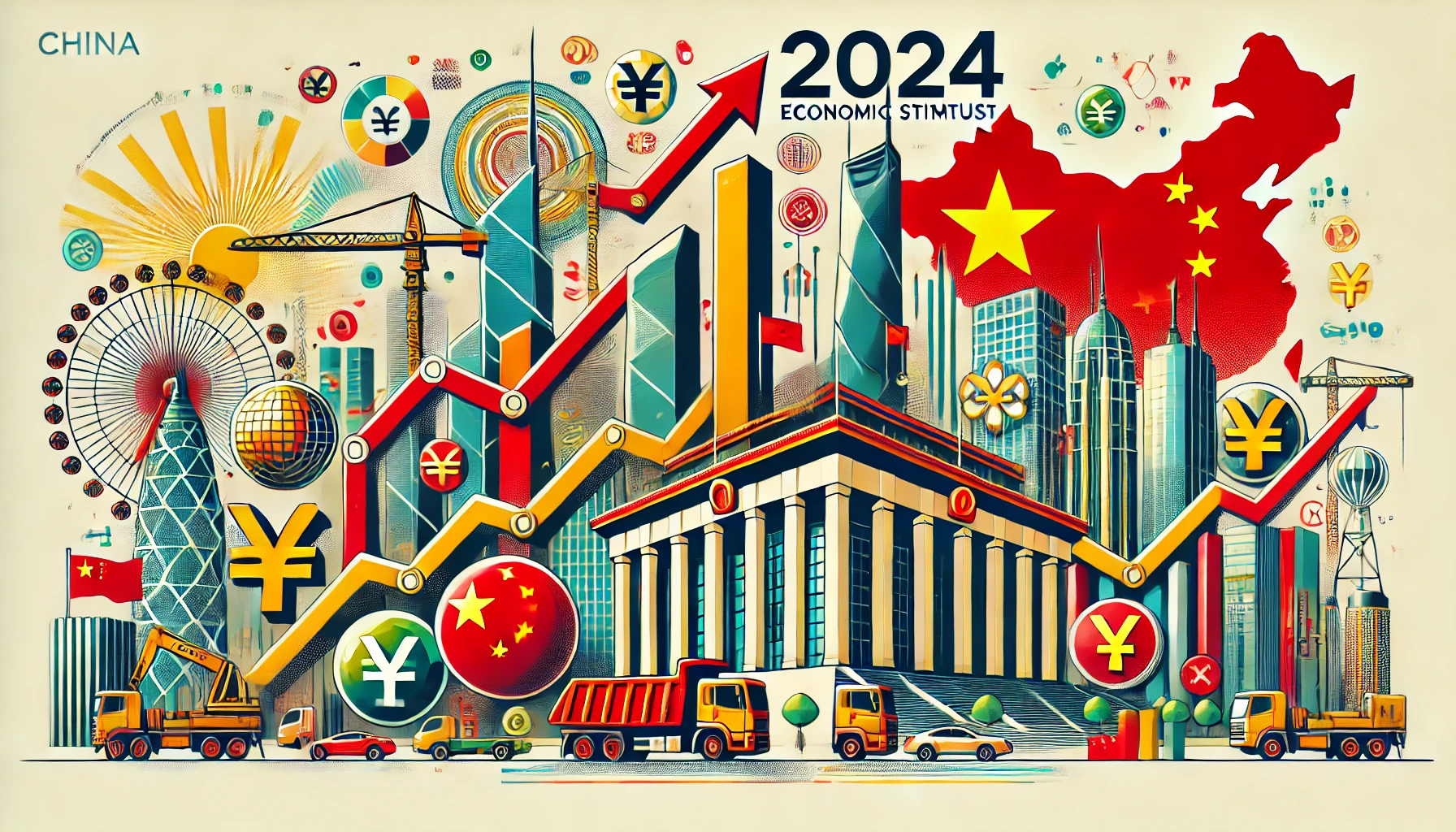China’s 2024 Economic Stimulus: Breaking Down Fiscal Policy and the People’s Bank of China’s Role
China’s economic recovery has faced significant challenges in recent years due to several factors, including the global pandemic, the downturn in the housing market, and slowing domestic demand. In 2024, China is implementing an aggressive economic stimulus plan, with major financial institutions and the People’s Bank of China (PBOC) at the forefront. With investors eyeing these measures closely, the government’s fiscal policy and stimulus plans are expected to have profound impacts on both domestic growth and global markets.
In this post, we’ll explore how China’s economic stimulus compares with past packages, what the 2024 fiscal policy entails, and how investors are reacting to the government’s efforts to stimulate the economy.
China’s Economic Stimulus: What’s in the Plan?
China’s government unveiled one of its largest-ever stimulus packages in 2024, designed to stabilize its slowing economy. The total size of the plan is estimated at 7.5 trillion yuan ($1.07 trillion), which accounts for roughly 6% of China’s GDP(South China Morning Post). This stimulus aims to boost several key areas, including the property sector, consumption, and stock market performance.
Key Features of the 2024 Stimulus Plan
The China economic stimulus package includes:
- A 2.5 trillion yuan cut in mortgage debt, easing pressure on homeowners and boosting consumer spending.
- An additional 2 trillion yuan in bond issuance, designed to fund local government infrastructure projects.
- 800 billion yuan to support the stock market, including liquidity provisions to ensure market stability(SouthChina Morning Post)(Investopedia).
- Capital injections for state-owned banks to increase lending and foster investment in key sectors such as technology and green energy.
These measures are part of a broader effort by Beijing to not only jumpstart growth but also prevent further economic stagnation, especially in the housing and property sectors, which have been significantly impacted over the past few years.
The Role of the People’s Bank of China (PBOC)
The People’s Bank of China stimulus plan plays a critical role in supporting the overall recovery strategy. As the nation’s central bank, the PBOC has enacted multiple monetary measures, including policy rate cuts and adjustments to the reserve requirement ratio (RRR), to boost liquidity in the banking sector and encourage lending(Investopedia).
PBOC’s Policy Rate Cuts and Impact on the Economy
In 2024, the People’s Bank of China lowered its 14-day reverse repo rate, a key tool used to inject short-term liquidity into the banking system. Additionally, the central bank reduced the amount banks are required to hold as reserves, allowing for more lending to businesses and individuals(Investopedia).
These moves are part of the central bank’s broader monetary policy aimed at ensuring that China achieves its target of 5% economic growth in 2024. By lowering borrowing costs and increasing the money supply, the PBOC is providing the financial backbone necessary to support the China government stimulus plan and boost domestic consumption and investment.
Stimulus and China’s Fiscal Policy in 2024
China’s fiscal policy in 2024 is deeply intertwined with its broader stimulus efforts. The government’s approach has been to increase public spending while simultaneously reducing tax burdens on businesses and individuals. These measures are designed to stimulate growth in key areas like infrastructure, manufacturing, and high-tech industries.
What Does China’s Fiscal Policy Entail?
The 2024 China fiscal policy includes:
- Significant investments in infrastructure projects, aimed at creating jobs and boosting domestic demand.
- Tax cuts for small- and medium-sized enterprises (SMEs), encouraging innovation and investment in growth sectors such as clean energy and technology.
- Increased subsidies for rural development and green energy projects, helping to meet China’s long-term sustainability goals.
This approach reflects China’s commitment to driving economic growth through public sector involvement while also reducing debt pressures in the private sector. Combined with the PBOC’s stimulus measures, these fiscal policies are expected to help the nation rebound from its recent economic challenges.
Investors Eye China’s Economic Growth Potential
The introduction of such a massive China economic stimulus package has captured the attention of global investors. Many are particularly interested in how these measures will impact China’s stock market and GDP forecast for 2024. According to analysts, China’s stimulus could drive growth in both the domestic economy and key sectors like real estate, technology, and renewable energy(South China Morning Post).
China’s 2024 GDP Forecast
China has set a modest target of 5% GDP growth for 2024, but the effectiveness of its stimulus efforts will be critical in achieving this goal. The China GDP forecast is being closely monitored by international investors, who are assessing the potential for further growth in emerging markets(Investopedia).
Additionally, the government’s focus on propping up the struggling housing sector and providing liquidity to the stock market is seen as a key indicator of whether these economic measures will succeed. So far, economists are cautiously optimistic, pointing to the positive impacts of the China stock market stimulus and broader government intervention.
China’s Housing Market Recovery and the Stimulus Plan
A critical component of China’s 2024 economic stimulus is the focus on the housing market recovery. China’s property sector has struggled in recent years due to debt issues and declining demand, leading to significant risks for the overall economy. To address this, the Chinese government has introduced measures aimed at stabilizing property prices and encouraging home purchases.
Housing Market Stimulus Measures
The 2024 stimulus package includes:
- Mortgage debt relief, which reduces the burden on homeowners and supports the recovery of real estate sales.
- Policies to support developers, ensuring that construction projects are completed on time and that new developments meet market demand(South China Morning Post)(Investopedia).
These measures are essential in reviving China’s housing market, which in turn affects consumer confidence and broader economic activity.
What to Expect from China’s Economic Briefing
China’s recent ad-hoc press briefing has fueled speculation that additional economic stimulus measures could be on the horizon. Investors are keenly watching for signs of further policy rate cuts or adjustments to fiscal policy, particularly in sectors such as housing, technology, and green energy.
The Chinese economic briefing offers crucial insights into how the government plans to navigate the next phase of its economic recovery, with particular attention on how these policies will impact both domestic and international markets.
China’s Economic Stimulus and Investor Outlook
In 2024, China’s economic stimulus plan, supported by the People’s Bank of China and fiscal policy reforms, is positioned to drive significant growth in key sectors. From efforts to revive the housing market to boosts in stock market liquidity, the government’s actions aim to restore confidence in the Chinese economy and meet its ambitious GDP forecast.
Investors are closely eyeing China’s next moves, particularly any additional stimulus measures that may arise from future briefings. With the People’s Bank of China stimulus measures already in motion, the coming months will determine the success of China’s efforts to rejuvenate its economy and deliver long-term, sustainable growth.
For more detailed insights into China’s economic policies and their impact on global markets, visit Regent Studies for expert analyses and resources.
For further information on China’s stimulus and economic policies, you can explore more on Investopedia(Investopedia)(South China Morning Post).



